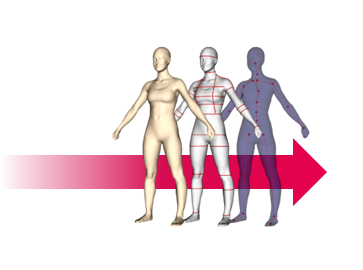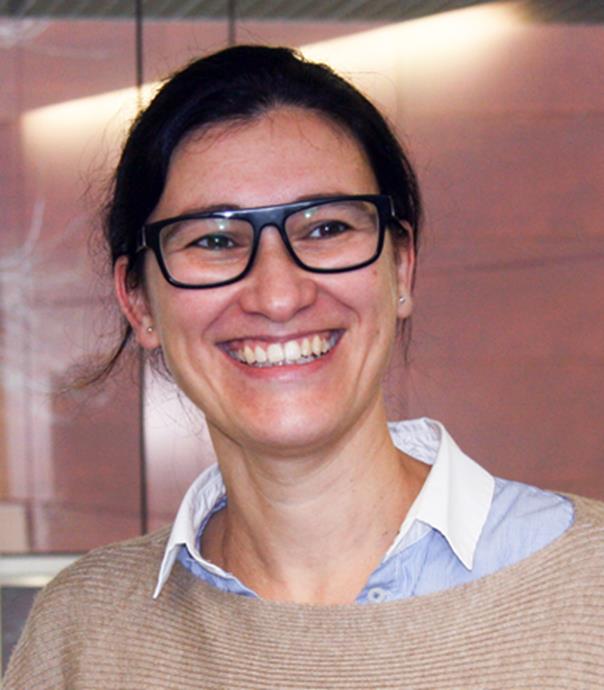
World Engineering Anthropometry Resource
- HOME
- LECTURE SERIES
- WEAR Lecture Series Lecture Abstracts and Presenters
WEAR Lecture Series 2022
Lecture Abstracts and Presenters
WEAR Lecture Series Abstracts
|
Lecture Title: How to create a 3D body avatar: A review of methodologies and potential applications |
|
Lecture Presenter: Sandra Alemany |
|
Affiliation: Instituto de Biomecánica de Valencia (Spain) |
|
Lecture Description: Human body metrics have become a significant source of product innovation to industries where consumer fit, comfort and ergonomic considerations are key factors. This is especially the case for fashion (e.g. footwear or apparel), health (e.g. orthotics or prosthetics), transport and aerospace (e.g. seats or human-machine interfaces), and safety (e.g. protective equipment or workstations) among others. In the last few years, emerging businesses using 3D body data (e.g. garment and footwear customization, size recommendation, health monitoring) are using the 3D body avatars as a human centric approach to offer new services adapted to consumer personal data. This webinar will do a review of: 1) different methods to create 3D body avatars: body scanning, body capture with a phone and generation of 3D body avatars from measurements and 2) applications of 3D body avatars. |
|
Lecture Title: Move4D: Capture and processing of body avatars in motion |
|
Lecture Presenter: Sandra Alemany |
|
Affiliation: Instituto de Biomecánica de Valencia (Spain) |
|
Lecture Description: Nowadays, 3D body scanners are used in many industrial and health applications. Typically, a single body scan of a person minimally clothed in A-pose is obtained to get measurements or 3D surfaces that are used to develop a garment, a helmet or an orthotic device. However, the use of most of these wearable products also involves human motion. To cope with this need, different technologies have been developed over past years to obtain 3D scans over time (so-called temporal 3D scanners or 4D scanners). The ability to process a 3D scan is essential to obtain accurate metrics and “clean” and complete 3D models that facilitate product design and virtual simulation. The automatic processing of markerless human 3D scans is not trivial, especially in non-standard poses. It becomes even more challenging in the case of processing a series of 3D scans of humans performing real-life or sports movements. This webinar will be focussed on the capture and processing of 3D body scans in motions. Potential applications will be also introduced.   
|
|
Lecture Title: Predicting Fit with Soft Avatars |
|
Lecture Presenter: Prof. Dinesh K. Pai, Computer Science |
|
Lecture Description: 3D avatars used in the apparel industry are hard. They do not behave like real human bodies and do not change shape in response to the garments. This is a major challenge for use of 3D technologies for predicting fit, especially for close-to-body garments such as intimates, athletic apparel, swimwear, and footwear. I will describe how high quality virtual fit testing can be achieved using VitalFit, a virtual fit testing platform developed by Vital Mechanics. The soft avatar technology was initially developed at UBC, in a multi-year effort to capture not only the 3D shape of a human body but also its physical properties, including elasticity, soft tissue volume, and how the body responds to touch with garments and other objects. The project has measured more than a hundred human participants, from diverse populations, and created the world's first database of soft tissue properties. These tissue properties are used in finite element (FEM) models of the human body and its interaction with garments. In parallel efforts, we are also measuring physical properties of real garments, and realistic tissue movement during dynamic activities. Existing patterns developed in garment CAD systems can now be simulated with soft avatars. I will present results of this process in creating personalized digital avatars and evaluating the fit of close-to-body garments. |
|
Lecture Title: Virtual Fitting |
|
Lecture Presenter: Prof. Hein Daanen, Sizing Science |
|
Lecture Description: The percentage of clothing sales using dedicated websites is rapidly increasing to the expense of sales in physical clothing stores. This process is accelerated due to the COVID pandemic. In a physical shop the customer can fit a garment and leave with a fitting garment size. In web shopping, however, the customer has to indicate which size is desired. Due to vanity sizing, absence of body dimension awareness and inconsistency in size indications in garments, the customer often gets clothing by mail that is not fitting. Several companies provide the service to send multiple clothing sizes and offer free returns. This is an expensive and environmental unfriendly solution. Virtual fitting may reduce the number of undesired returns. The customer submits a 3D scan (or a 3d model based on objective or subjective information on body dimensions) to the manufacturer that fits the garment on the virtual body or model to select the correct size. Several software packages offer this capability, such as Lectra, Vidya, Clo3D or Optitex. Fit assessment can be assisted by calculation of the volume between garment and body, visualization of stretch in the garment or visualization of a transparent garment over the body. Batch processing is possible and new developments in dynamic fit evaluation have been started. Currently, however, good scientific research validating the tools and results is still lacking. In the presentation, an overview will be given regarding the current status, mainly based on military research, with a discussion regarding prospects for the civilian market. |
WEAR Lecture Series Presenters
|
Presenter: Sandra Alemany |
|
Affiliation: Instituto de Biomecánica de Valencia (Spain) |

Sandra Alemany, head of the Anthropometry Research Group of the Instituto de Biomecánica de Valencia (IBV). She started working at IBV in 2000 as researcher focused on fitting and anthropometry applied to ergonomic product design. In this position, she was project leader of large-scale anthropometry surveys in Spain using 3D scanning technology. She boosted also the acquisition and exchange of international 3D body scan data obtaining as a result a database of more than 200k 3D body scans in different postures representing different population is Europe, EEUU and Asia, an important asset for ergonomic product design and data driven models. She founded the Anthropometry Research Group at IBV in 2015, a multi-disciplinary team combining knowledge and expertise about anatomy, anthropometry measuring, 3D scanning, 3D body processing, computer vision, statistical analysis, deep learning fitting and product design. These unique combination of expertise enables the team to cover all the anthropometric data value chain from the body capture to the application in product conceptualization and design. She coordinates the research activity and roadmap of the different research lines of this team in collaboration with the marketing team of the Institute. The latest projects that she led is the development of a new 4D body scanner laboratory, a breakthrough technology to for dynamic digital human modeling. At this moment, this development is being commercialized under the brand Move4D. She is member of the World Engineering Anthropometry Resource Association (WEAR), an international group of experts on 3D anthropometrics. Expert advisor on European Standardization Committees of Anthropometry and Size System of Clothing. Co-Chair of the Technical Committee of the IEA (International Ergonomic Association). Member of the Fit Subgroup of the 3D Body Processing committee of the IEEE. Expert reviewer of research projects for the European Commission. |
|
Presenter: Prof. Dinesh K. Pai |
|
Dinesh K. Pai is a Professor of Computer Science at the University of British Columbia, and founder of Vital Mechanics Research - a startup developing high-fidelity soft avatars for apparel fit testing. His current research is focused on data-driven digital human models, frictional contact between soft objects, machine learning for design, and technology for efficient measurement of material properties. His research is multidisciplinary, spanning computer graphics, scientific computing, computational mechanics, artificial intelligence, robotics, biomechanics, and the neural control of movement. He has received many prestigious recognitions, including a Tier 1 Canada Research Chair, the 2020 CHCCS Achievement Award for Computer Graphics, UBC's Killam Research Prize, three NSERC Discovery Accelerator/Supplement Awards, and an international Human Frontier Science Program grant. A dozen of his trainees are now faculty at leading institutions, including Stanford, Toronto and McGill. Dr. Pai has been a Professor at Rutgers University and has held visiting professorships at Carnegie Mellon University's Robotics Institute, New York University's Center for Neural Science, the University of Siena (as Santa Chiara Chair in Cognitive Science), and the Collège de France, Paris (elected Professeur Invité). He received his Ph.D. from Cornell University, Ithaca, NY, and his B.Tech. degree from the Indian Institute of Technology, Madras. See https://sensorimotor.cs.ubc.ca/pai/ and https://www.vitalmechanics.com/ for more information. |
|
Presenter: Prof. Hein Daanen |
|
Prof. Dr. Hein Daanen is head of the physiology section of the department of human movement sciences, faculty of behavioural and movement sciences of Vrije Universiteit Amsterdam, director of the master human movement sciences (about 150 students yearly) and director of the company Sizing Science. Sizing Science (www.sizingscience.nl) is dedicated to optimize sizing and fit of products linked to the human body. Hein Daanen served as chairman for NATO research and technology group HFM-266 on ‘3D scanning for clothing fit and logistics’. This working group was awarded in 2021 with the NATO panel excellence award. The expertise of Hein Daanen included thermal physiology, adaptation of humans to heat and cold, and 3D anthropometry. He was president of human factors Netherlands, and currently serves as chair of the yearly price for the best thesis regarding ergonomics. Under the leadership of Dr. Robinette, Hein Daanen organized the CAESAR survey and published several papers on 3D body scanning. Hein is a founding member of the World Engineering Anthropometry Resource Association (WEAR), an international group of experts on 3D anthropometrics. For more info please visit www.heindaanen.nl. |

